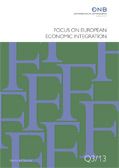Focus on European Economic Integration Q4/17
 OeNB
OeNB
- Erschienen:
- Dezember 2017
 OeNB
OeNB
Call for applications (PDF, 43 kB) en 11.12.2017, 00:00:00
Developments in selected CESEE countries (PDF, 402 kB) en 11.12.2017, 00:00:00
Outlook for selected CESEE countries (PDF, 157 kB) en 11.12.2017, 00:00:00
Migration intentions in CESEE – a descriptive analysis (PDF, 212 kB) Raggl. Against the background of high emigration from Central, Eastern and Southeastern Europe (CESEE) in the past few decades, we study the current migration intentions of individuals in ten CESEE countries using individual-level data from the 2014 wave of the OeNB Euro Survey. Apart from the overall share of people that intend to leave their home countries, we identify the gender, age and education profiles of these prospective migrants. Using population pyramids for visualization, we compare the current population structure with a hypothetical one that would arise if all people planning to emigrate would in fact do so. We find that, on average, 11.4% of individuals aged 25 to 39 intend to leave their CESEE home countries, a share that represents a lower-bound estimate. Migration intentions vary considerably across countries; in general, they appear to be more common among men and among individuals with a relatively low level of education. en migration intentions, population pyramids, CESEE F22, J11, O52 11.12.2017, 00:00:00
The New Silk Road, part II: implications for Europe (PDF, 340 kB) Barisitz, Radzyner. Through the New Silk Road (NSR) initiative, China increasingly invests in building and modernizing overland and maritime infrastructures with a view to enhancing the overall connectivity between China and Europe. The NSR runs through a number of Eurasian emerging markets and extends to Southeastern Europe (SEE), where Chinese investments include the modernization of ports and highspeed rail and road projects to speed up the transport of goods between China and Europe (e.g. port of Piraeus, rail connection to Budapest). Participation in the NSR will probably stimulate SEE’s economic expansion and may even contribute to overcoming its traditional peripheral position in Europe. Ideally, SEE will play a role in catalyzing a deepening of China-EU economic relations, e.g. by facilitating European exports to China and other countries along NSR trajectories, which would boost growth in Europe more widely. In the long run, these developments might also influence the EU’s political and economic positioning on a global scale. en New Silk Road, One Belt, One Road, connectivity, trade infrastructure, economic F15, F34, N75, R12, R42 11.12.2017, 00:00:00
CESEE-related abstracts from other OeNB publications (PDF, 64 kB) en 11.12.2017, 00:00:00
The OeNB’s 81st East Jour Fixe: Nonperforming loans in CESEE – macroeconomic dimension and resolution strategies (PDF, 82 kB) en 11.12.2017, 00:00:00
22nd Global Economy Lecture: David Dorn on “The rise of the machines – how computers have changed work” (PDF, 56 kB) en 11.12.2017, 00:00:00
Statistical annex (PDF, 72 kB) en 11.12.2017, 00:00:00